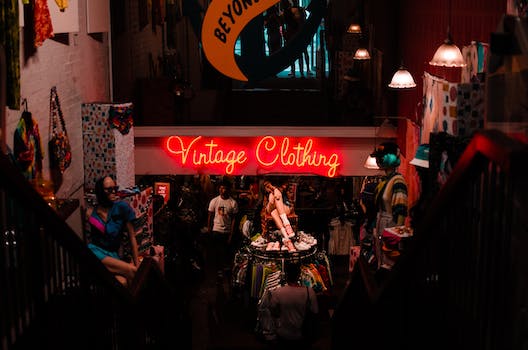How To Make Money Selling Vintage Clothes
“Unlock the hidden value in your closet with vintage clothing sales.”
Introduction
Selling vintage clothes can be a lucrative business for those who have an eye for fashion and a passion for history. With the rise of sustainable fashion and the popularity of vintage styles, there is a growing demand for unique and one-of-a-kind pieces. In this article, we will explore some tips and strategies for how to make money selling vintage clothes.
Finding Hidden Gems: Tips for Sourcing Vintage Clothing to Sell
Are you a fashion enthusiast with a passion for vintage clothing? Do you have an eye for unique pieces that others may overlook? If so, you may be able to turn your love for vintage fashion into a profitable business. Selling vintage clothing can be a lucrative venture, but it requires a keen eye for quality and a knack for finding hidden gems. In this article, we’ll share some tips for sourcing vintage clothing to sell.
First and foremost, it’s important to know where to look for vintage clothing. Thrift stores, estate sales, flea markets, and online marketplaces like eBay and Etsy are all great places to start. When searching for vintage clothing, it’s important to keep an open mind and be willing to dig through piles of clothing to find the hidden gems.
When sourcing vintage clothing, it’s important to pay attention to the quality of the garments. Look for pieces that are made from high-quality materials and are in good condition. Check for any stains, tears, or holes, as these can significantly decrease the value of the garment. It’s also important to pay attention to the brand and the era in which the garment was made. Certain brands and eras are more sought after than others, and can command a higher price.
Another important factor to consider when sourcing vintage clothing is the size and fit of the garment. While some vintage pieces may be one-of-a-kind and therefore not size-specific, it’s important to keep in mind that many vintage garments were made in smaller sizes than what is commonly worn today. It’s important to know your target market and what sizes they are looking for.
When sourcing vintage clothing, it’s also important to consider the current fashion trends. While vintage clothing is often timeless and can be worn in any era, certain styles and trends may be more popular at certain times. Keeping up with current fashion trends can help you determine which pieces are likely to sell quickly.
Once you’ve sourced your vintage clothing, it’s important to properly clean and care for the garments. Many vintage pieces require special care, such as hand washing or dry cleaning. It’s important to follow the care instructions on the garment’s label to ensure that it remains in good condition.
When it comes to pricing your vintage clothing, it’s important to do your research. Look at similar pieces that have sold recently and determine a fair price based on the condition, brand, and rarity of the garment. It’s also important to consider the cost of any repairs or cleaning that may be necessary.
Finally, when selling vintage clothing, it’s important to have a strong online presence. Utilize social media platforms like Instagram and Facebook to showcase your inventory and connect with potential customers. Consider creating an online store on platforms like Etsy or eBay to reach a wider audience.
In conclusion, sourcing and selling vintage clothing can be a profitable and rewarding venture for those with a passion for fashion. By keeping an eye out for quality pieces, paying attention to current fashion trends, properly caring for your inventory, and pricing your garments fairly, you can turn your love for vintage fashion into a successful business.
Pricing Your Vintage Finds: Strategies for Maximizing Profit

If you’re a vintage clothing enthusiast, you may have considered selling your finds to make some extra cash. But how do you price your vintage pieces to ensure you’re making a profit? Here are some strategies for maximizing your profit when selling vintage clothes.
First, do your research. Look up similar items on online marketplaces like Etsy or eBay to get an idea of what similar pieces are selling for. Take note of the condition, brand, and rarity of the items to get a better understanding of their value. You can also check out vintage clothing stores in your area to see what they’re pricing similar items at.
Next, consider the condition of the item. If it’s in excellent condition with no signs of wear or damage, you can price it higher than if it has some wear and tear. However, if the item is rare or highly sought after, it may still be worth a higher price even if it’s not in perfect condition.
Another factor to consider is the brand. Certain vintage brands like Levi’s or Chanel are highly sought after and can command a higher price. Do some research on the brand’s history and popularity to determine its value.
When pricing your vintage finds, it’s important to be realistic. While you may have an emotional attachment to the item, it’s important to remember that it’s only worth what someone is willing to pay for it. Don’t price your items too high or you may not get any offers.
Consider bundling items together to increase their value. For example, if you have a collection of vintage band t-shirts, you could bundle them together and sell them as a set. This can increase the perceived value of the items and make them more appealing to buyers.
When selling online, be sure to include detailed descriptions and high-quality photos of the items. This will help potential buyers get a better understanding of the item’s condition and value. Be honest about any flaws or damage and include measurements to ensure a good fit.
Finally, be open to negotiation. Some buyers may be willing to pay your asking price, while others may want to haggle. Consider setting a slightly higher price than what you’re willing to accept to leave room for negotiation.
In conclusion, pricing your vintage finds can be a tricky task, but with some research and consideration, you can maximize your profit. Remember to be realistic, consider the condition and brand of the item, bundle items together, and be open to negotiation. Happy selling!
Building Your Brand: Creating a Successful Online Vintage Clothing Shop
Are you a vintage clothing enthusiast looking to turn your passion into a profitable business? Selling vintage clothes online can be a lucrative venture, but it takes more than just a love for retro fashion to succeed. Building a successful online vintage clothing shop requires a solid brand strategy and a keen understanding of your target audience. Here are some tips to help you get started.
1. Define Your Brand
Before you start selling vintage clothes online, you need to define your brand. What makes your shop unique? What kind of vintage clothing do you specialize in? Who is your target audience? These are all important questions to consider when building your brand.
Your brand should reflect your personal style and values, and it should resonate with your target audience. Take some time to research your competition and identify gaps in the market that you can fill. This will help you differentiate your brand and stand out in a crowded marketplace.
2. Build Your Online Presence
Once you have defined your brand, it’s time to build your online presence. This includes creating a website or online store, as well as social media profiles on platforms like Instagram and Facebook. Your website should be easy to navigate and visually appealing, with high-quality photos of your vintage clothing.
Social media is a powerful tool for building your brand and connecting with your target audience. Use platforms like Instagram to showcase your vintage clothing and engage with your followers. You can also use social media to promote sales and special offers, as well as to collaborate with other vintage clothing sellers and influencers.
3. Curate Your Collection
One of the most important aspects of running a successful online vintage clothing shop is curating your collection. Your vintage clothing should be high-quality, unique, and on-trend. You should also have a good mix of styles and sizes to appeal to a wide range of customers.
When sourcing vintage clothing, it’s important to be selective. Look for pieces that are in good condition and have a timeless appeal. You can find vintage clothing at thrift stores, estate sales, and online marketplaces like eBay and Etsy.
4. Price Your Vintage Clothing
Pricing your vintage clothing can be tricky. You want to make a profit, but you also don’t want to price yourself out of the market. Research your competition and price your vintage clothing competitively. You can also offer sales and discounts to entice customers to buy.
5. Provide Excellent Customer Service
Providing excellent customer service is key to building a successful online vintage clothing shop. Respond to customer inquiries promptly and professionally, and be transparent about your shipping and return policies. You should also package your vintage clothing carefully to ensure it arrives in good condition.
6. Market Your Vintage Clothing Shop
Marketing your vintage clothing shop is essential to attracting new customers and building your brand. You can use social media, email marketing, and paid advertising to promote your shop. You can also collaborate with other vintage clothing sellers and influencers to reach a wider audience.
In conclusion, building a successful online vintage clothing shop takes time, effort, and a solid brand strategy. By defining your brand, building your online presence, curating your collection, pricing your vintage clothing competitively, providing excellent customer service, and marketing your shop, you can turn your passion for vintage fashion into a profitable business.
Marketing Your Vintage Clothing Business: Social Media and Beyond
If you’re passionate about vintage clothing and have a knack for finding unique pieces, you might be wondering how to turn your hobby into a profitable business. Selling vintage clothes can be a lucrative venture, but it requires more than just a good eye for fashion. You need to know how to market your business effectively to reach your target audience and stand out in a crowded market.
One of the most effective ways to market your vintage clothing business is through social media. Platforms like Instagram, Facebook, and Pinterest are ideal for showcasing your inventory and connecting with potential customers. Here are some tips for using social media to promote your vintage clothing business:
1. Create a cohesive brand image
Your social media profiles should reflect the aesthetic of your vintage clothing business. Use a consistent color scheme, font, and tone of voice across all platforms to create a cohesive brand image. This will help your followers recognize your brand and differentiate it from competitors.
2. Post high-quality photos
The quality of your photos can make or break your social media presence. Invest in a good camera or smartphone and take photos in natural light to showcase the true colors and textures of your vintage pieces. Use editing tools to enhance your photos and make them stand out in a crowded feed.
3. Use hashtags
Hashtags are a powerful tool for reaching new audiences on social media. Research popular hashtags in the vintage clothing niche and use them in your posts to increase visibility. You can also create your own branded hashtags to encourage user-generated content and build a community around your brand.
4. Engage with your followers
Social media is a two-way conversation, so make sure to engage with your followers regularly. Respond to comments and messages promptly, and ask for feedback on your inventory and customer service. This will help you build a loyal following and improve your business over time.
In addition to social media, there are other ways to market your vintage clothing business and reach new customers. Here are some ideas to consider:
1. Attend vintage fairs and markets
Vintage fairs and markets are a great way to connect with customers in person and showcase your inventory. Research local events in your area and apply to be a vendor. Make sure to bring a variety of pieces and price them competitively to attract buyers.
2. Collaborate with influencers
Influencer marketing can be a powerful tool for reaching new audiences and building brand awareness. Identify influencers in the vintage clothing niche and reach out to them to collaborate on a sponsored post or giveaway. This can help you reach a wider audience and build credibility with potential customers.
3. Offer discounts and promotions
Everyone loves a good deal, so consider offering discounts and promotions to attract new customers. You can offer a percentage off a customer’s first purchase, free shipping, or a buy-one-get-one-free deal. Make sure to promote your discounts on social media and your website to maximize their impact.
4. Build an email list
Email marketing is a cost-effective way to reach your target audience and promote your inventory. Offer a discount or freebie in exchange for email sign-ups, and send regular newsletters with new arrivals, promotions, and styling tips. This will help you build a loyal customer base and drive repeat business.
In conclusion, marketing your vintage clothing business requires a multi-faceted approach that includes social media, in-person events, influencer collaborations, and email marketing. By using these strategies effectively, you can build a strong brand image, reach new customers, and grow your business over time. Remember to stay true to your unique aesthetic and provide excellent customer service to stand out in a crowded market.
Staying Ahead of the Trends: How to Keep Your Vintage Clothing Inventory Fresh
Are you a vintage clothing enthusiast looking to turn your passion into a profitable business? Selling vintage clothes can be a lucrative venture, but it requires a keen eye for fashion and a deep understanding of the market. One of the most important aspects of running a successful vintage clothing business is staying ahead of the trends and keeping your inventory fresh. In this article, we’ll explore some tips and tricks for sourcing and curating vintage clothing that will keep your customers coming back for more.
First and foremost, it’s important to stay up-to-date on current fashion trends. While vintage clothing is all about nostalgia and retro style, it’s important to remember that your customers are still looking for pieces that feel fresh and modern. Keep an eye on fashion blogs, social media influencers, and celebrity style to get a sense of what’s currently in vogue. This will help you identify which vintage pieces are likely to sell well and which ones might be better left on the rack.
Another key strategy for keeping your inventory fresh is to constantly be on the lookout for new sources of vintage clothing. While thrift stores and estate sales are great places to start, they can quickly become picked over and stale. Consider branching out to online marketplaces like eBay and Etsy, where you can find unique and rare vintage pieces from all over the world. You can also attend vintage clothing fairs and trade shows to connect with other sellers and discover new sources of inventory.
When curating your vintage clothing collection, it’s important to strike a balance between classic pieces and trendier items. While timeless pieces like denim jackets and leather boots will always be in style, it’s also important to offer your customers pieces that feel fresh and current. Look for vintage pieces that incorporate current trends, like oversized blazers, statement sleeves, and bold prints. These pieces will help your customers feel like they’re getting something unique and on-trend, while still maintaining the vintage aesthetic they love.
Finally, don’t be afraid to get creative with your vintage clothing offerings. While clothing is obviously the main focus of your business, there are plenty of other vintage items that can help set your store apart. Consider offering vintage accessories like jewelry, hats, and bags, or even vintage home decor items like lamps and furniture. These unique offerings will help your store stand out from the competition and give your customers a reason to keep coming back.
In conclusion, running a successful vintage clothing business requires a combination of fashion savvy, business acumen, and a willingness to stay ahead of the trends. By keeping an eye on current fashion trends, constantly seeking out new sources of inventory, and curating a collection that balances classic pieces with trendier items, you can create a vintage clothing business that is both profitable and beloved by customers. So go forth and start scouring those thrift stores and estate sales – the world of vintage fashion is waiting for you!
Conclusion
Conclusion: Selling vintage clothes can be a profitable business if done correctly. It requires knowledge of the market, a good eye for quality pieces, and effective marketing strategies. By following these tips, you can increase your chances of success and make money selling vintage clothes.




